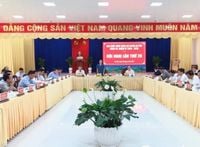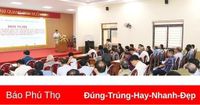In a significant move toward administrative efficiency, Phu Tho province is actively implementing the Central Government's policy to merge certain administrative units at the provincial level while eliminating the district level and reorganizing commune-level administrative units. This initiative aims to streamline governance and enhance service delivery to the public.
The province has developed a comprehensive plan for the arrangement of commune-level administrative units for the year 2025. According to this project, Phu Tho will have a total of 207 administrative units, comprising 180 communes, 15 wards, and 12 towns. Following the principles outlined in Resolution No. 75-NQ/UBTVQH dated April 14, 2025, from the National Assembly Standing Committee, Phu Tho will see 205 commune-level administrative units undergo restructuring, including 178 communes, 15 wards, and 12 towns. Notably, two communes, Trung Son in Yen Lap and Thu Cuc in Tan Son, meet the necessary standards and will not be reorganized.
After the restructuring, the province will feature 66 new commune-level administrative units, which include 7 wards and 59 communes, resulting in a reduction of 141 units, or 68.12%. This transformation represents a substantial shift in the province's administrative landscape.
Community engagement has been a cornerstone of this process. Over 20,000 voters representing households across nine communes and wards in Phu Tho town expressed their support for the proposed projects. The town itself will reduce its administrative units from nine to three wards: Phu Tho, Au Co, and Phong Chau.
Bui Dinh Ung, a party member from Thanh Minh commune in Phu Tho town, remarked on the significance of this initiative, stating, "When the local officials promoted the project to merge the commune-level administrative units, I fully supported the government's direction. I believe this change will lead to a brighter future." His sentiments echoed the views of more than 20,000 voters who also endorsed the proposals.
Trần Văn Niên, another party member from Phu Ho commune, noted the anticipated economic benefits of the merger. He stated, "After the merger, the potential for economic development will expand, and residents will have broader connections and interactions, leading to a richer cultural life."
To ensure a robust process for gathering public opinion on the administrative unit restructuring proposals, local authorities have intensified their outreach efforts. They aim to inform citizens about the necessity of the changes at both the provincial and commune levels. The province organized a public consultation to gather feedback on the restructuring plans for Phu Tho, Vinh Phuc, and Hoa Binh provinces, as well as the commune-level restructuring for Phu Tho in 2025.
The results of this consultation were overwhelmingly positive, with 98.30% of voters agreeing to the administrative unit arrangement project for Phu Tho, Vinh Phuc, and Hoa Binh provinces, and 97.58% supporting the commune-level restructuring project for Phu Tho province in 2025.
This decisive action from the provincial government reflects a commitment to efficiency and modernization in governance. The high level of public support for these projects indicates a collective belief in their potential to reshape local governance positively.
Meanwhile, in Ho Chi Minh City, a similar initiative is underway. On May 6, 2025, the People's Committee of Ho Chi Minh City announced the formation of a working group tasked with implementing the arrangement of administrative units and building a two-level government model. This model is designed to streamline governance by establishing a clear structure at the city level and the ward, commune, and town levels.
The working group, led by Vice Chairman Vo Van Hoan, consists of leaders from various municipal departments and representatives from different districts. Its primary responsibilities include preparing plans for the arrangement of provincial and commune-level administrative units, ensuring compliance with regulations, and aligning the restructuring efforts with local realities.
The working group will also solicit public input and present its findings to the local People's Councils for consideration before finalizing the proposals for submission to the National Assembly and the National Assembly Standing Committee. This collaborative approach aims to facilitate a smooth transition that will not disrupt citizens' rights.
Currently, Ho Chi Minh City comprises Thu Duc City, 16 districts, and 5 rural districts, many of which have wards and communes that do not meet the new criteria regarding area size and population. The restructuring is expected to create a more rational administrative system that aligns with the city's demographic characteristics and urban development needs.
Back in Nghệ An province, on May 7, the Party Committee and the Provincial Military Command convened a conference to hand over the responsibilities of the Commander of the Military Command of Nghệ An province. This event coincided with discussions in the National Assembly regarding significant legislative amendments, including the draft resolution to amend the 2013 Constitution and the draft laws on local government organization and civil servants.
During the same session, the National Assembly addressed the implementation of Resolution 11 from the Central Government, focusing on the rearrangement of administrative structures. The Steering Committee for the arrangement of commune-level administrative units in Nghệ An has encouraged localities to reconsider the naming conventions for these units post-restructuring, advocating for names that do not rely on ordinal numbers.
In Vinh City, Nghệ An province, the People's Council unanimously approved the renaming of new commune-level administrative units on May 7, after previously considering names based on numbers. The new names, such as Truong Vinh, Thanh Vinh, Vinh Hung, Vinh Phu, and Vinh Loc, reflect a commitment to cultural identity and local heritage.
The decision to rename these wards, despite a previous public agreement of 65.48% in favor of the ordinal number system, highlights the local government's responsiveness to feedback from the Provincial Party Committee, which recommended avoiding numbered names for new administrative units.
As Vietnam navigates these transformative changes in its administrative landscape, the commitment to enhancing governance and fostering community engagement remains paramount. The ongoing restructuring efforts across provinces reflect a broader vision for a more efficient and responsive government, poised to meet the evolving needs of its citizens.






